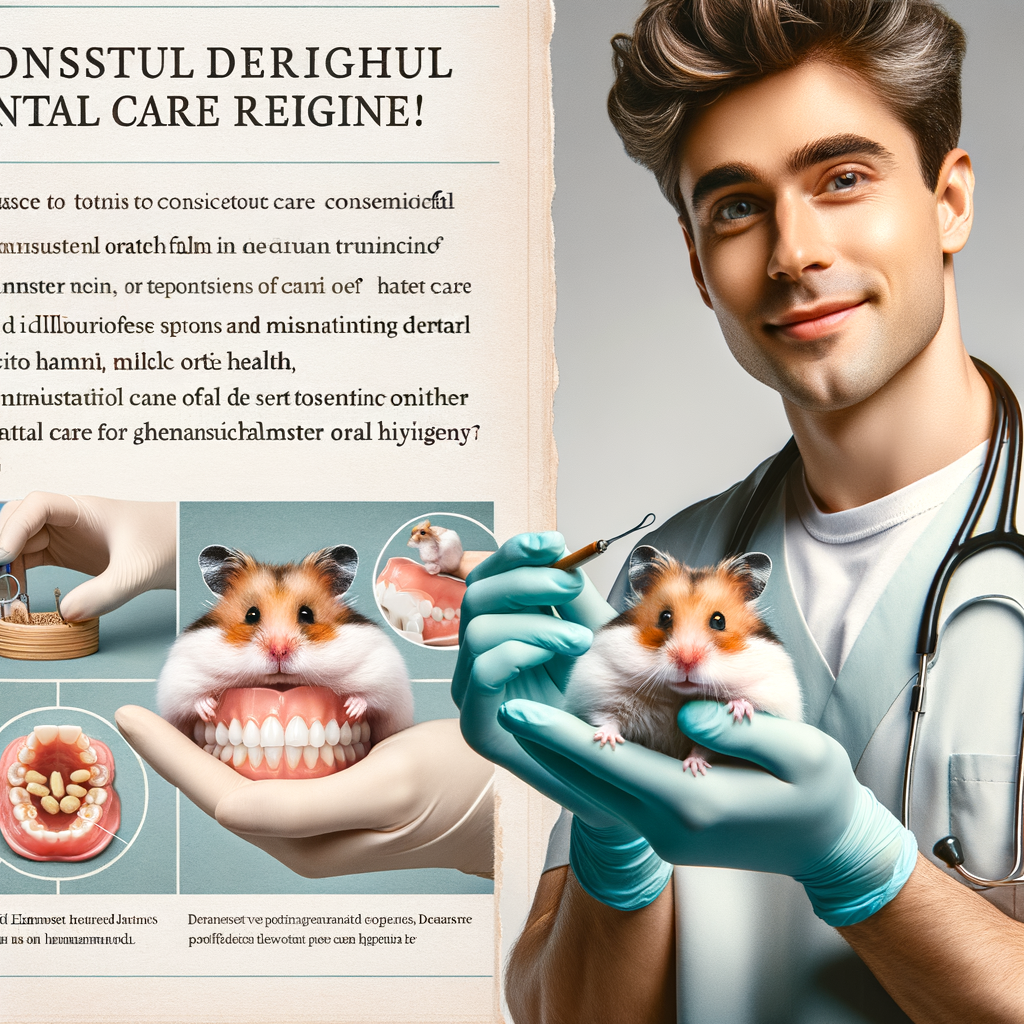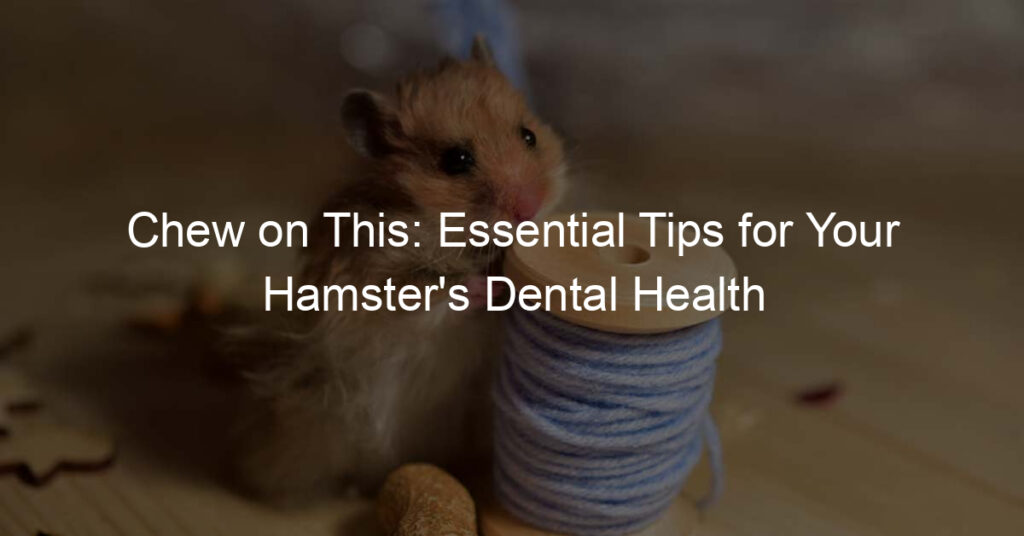
Introduction to Hamster Dental Care
Just like humans, hamsters also need proper dental care to stay healthy and happy. In this article, we will explore the importance of dental health in hamsters and discuss some common dental issues they may face.
-
Importance of Dental Health in Hamsters
Hamsters, like many other rodents, have teeth that continuously grow throughout their lives. This makes dental health incredibly important for them. If a hamster’s teeth become too long, it can lead to serious health issues.
Proper dental care can prevent these problems and ensure that your hamster stays healthy. It can also help your hamster eat properly, as long teeth can make it difficult for them to chew their food.
Regularly checking your hamster’s teeth and providing them with the right food to naturally grind down their teeth is a key part of hamster dental care.
-
Common Dental Issues in Hamsters
There are a few common dental issues that hamsters can face. One of the most common is overgrown teeth. This can happen if a hamster doesn’t have enough hard food to chew on, which helps to naturally grind down their teeth.
Other common dental issues include misaligned teeth and dental abscesses. Misaligned teeth can occur if a hamster’s teeth are not wearing down evenly, while dental abscesses can occur if a hamster’s tooth gets infected.
These issues can be serious, but with proper dental care and regular check-ups, they can be prevented or treated early on.
In the following sections, we will delve deeper into understanding hamster teeth, hamster teeth trimming, and tips for hamster dental health. Stay tuned to learn more about how to keep your hamster’s teeth healthy and strong!
Understanding Hamster Teeth
Hamsters are adorable creatures with unique dental characteristics. One of the most fascinating aspects of their anatomy is their teeth. Let’s delve into the world of hamster teeth and understand their growth process.
Hamster Teeth Growth
Hamster teeth growth is a fascinating process. It is different from humans and many other animals. Hamsters have two types of teeth: incisors and molars. But the growth process is similar for both types. Let’s explore how and why hamster teeth grow the way they do.
- How hamster teeth grow
- Why hamster teeth never stop growing
Hamster teeth start growing even before they are born. Yes, you read that right! Hamster teeth begin to develop while they are still in their mother’s womb. By the time they are born, their incisors are already visible. Their molars, however, take a bit longer and start appearing when they are about two weeks old.
Hamster teeth grow continuously throughout their life. This is because they are made of a substance called dentin, which is softer than the enamel that covers human teeth. Dentin wears down easily, so to compensate for this, hamster teeth keep growing.
Hamsters are natural chewers. They love to gnaw on things. This is not just a hobby for them, but a necessity. Chewing helps them keep their teeth at a manageable length. If they didn’t chew, their teeth would grow too long, making it difficult for them to eat or close their mouth.
Another reason why hamster teeth never stop growing is their diet. In the wild, hamsters eat a variety of foods, including seeds, nuts, fruits, and vegetables. These foods are hard and require a lot of chewing, which wears down their teeth. To ensure they always have strong, sharp teeth to break down their food, their teeth never stop growing.
In conclusion, understanding hamster teeth growth is essential for every hamster owner. It helps you provide the right diet and care for your pet, ensuring they live a healthy, happy life.
Types of Hamster Teeth
Hamsters, like humans, have different types of teeth that serve various functions. In this section, we will explore the two main types of hamster teeth: incisors and molars.
- Incisors
- Molars
Incisors are the front teeth of the hamster. They are sharp and chisel-shaped, perfect for gnawing and biting into food. These teeth are easily visible and are the first thing you notice when your hamster opens its mouth. They are designed to cut through hard surfaces like nuts and seeds, which are a significant part of a hamster’s diet. Incisors in hamsters never stop growing, so they need to constantly gnaw on things to keep them at the right length.
Molars are found further back in the hamster’s mouth. They are flat and strong, designed for grinding food into a paste for easy digestion. Unlike incisors, molars do not continuously grow. They are crucial for breaking down food into smaller pieces, making it easier for the hamster to swallow and digest its food. It’s harder to see the molars as they are located deep in the mouth, but they play an equally important role in the hamster’s dental health.
Understanding the different types of hamster teeth is essential for their dental care. Regular check-ups can help ensure that both their incisors and molars are in good health. Remember, a healthy hamster is a happy hamster!
Hamster Teeth Trimming
Hamsters, like other rodents, have teeth that grow continuously throughout their lives. This is why it’s essential to pay attention to their dental health, particularly teeth trimming. Let’s delve into why teeth trimming is crucial for your furry friend.
Why Teeth Trimming is Essential
Teeth trimming plays a vital role in maintaining your hamster’s overall health. It helps in:
- Preventing Overgrowth: Hamsters’ teeth never stop growing. If they don’t wear down naturally, they can become too long, making it difficult for your pet to eat. Overgrown teeth can also injure the hamster’s mouth or cheeks.
- Avoiding Dental Issues: Regular teeth trimming can help prevent dental problems like tooth decay and gum disease. These issues can cause discomfort and lead to serious health problems if left untreated.
It’s important to note that teeth trimming should be done carefully. If you’re unsure about how to do it, it’s best to seek help from a professional. Remember, your hamster’s health and comfort should always come first.
How to Trim Your Hamster’s Teeth
Trimming your hamster’s teeth is a crucial part of their overall health and well-being. There are two primary methods of trimming a hamster’s teeth: using chew toys and professional trimming. Both methods are effective and can be used depending on the situation and your comfort level.
- Using Chew Toys
- Professional Trimming
One of the easiest ways to maintain your hamster’s teeth is by providing them with chew toys. Hamsters have a natural instinct to chew, which helps keep their teeth at a manageable length. Chew toys made of wood, cardboard, or other safe materials can be an excellent choice for this purpose.
When choosing chew toys, make sure they are safe for your hamster. Avoid any toys with small parts that could be a choking hazard. Also, ensure the toys are non-toxic and hamster-safe. Regularly replace the chew toys once they become worn out or overly chewed.
If your hamster’s teeth become too long despite providing chew toys, it may be necessary to seek professional help. Veterinarians or professional pet groomers have the necessary tools and expertise to trim your hamster’s teeth safely and effectively.
Professional trimming should be considered a last resort, as it can be stressful for your hamster. However, in some cases, it may be the best option to prevent dental issues and ensure your hamster’s health. Always consult with a professional before deciding on this method.
In conclusion, maintaining your hamster’s dental health is essential for their overall well-being. Whether you choose to use chew toys or seek professional help, remember that regular monitoring and care can prevent many dental issues. Always consult with a vet if you have any concerns about your hamster’s teeth.
Tips for Hamster Dental Health
One of the most important aspects of maintaining your hamster’s dental health is their diet. A balanced diet not only ensures overall health but also plays a crucial role in keeping their teeth strong and healthy.
Diet for Healthy Teeth
Let’s delve into the importance of a balanced diet and the foods that are recommended for your hamster’s dental health.
- Importance of a Balanced Diet
- Recommended Foods for Dental Health
- Fruits and Vegetables: Apples, carrots, and broccoli are excellent choices. They are not only nutritious but also require a good amount of chewing, which helps keep your hamster’s teeth in check.
- Whole Grains: Foods like brown rice, oatmeal, and whole grain bread are great for your hamster’s dental health. They provide essential nutrients and help in teeth grinding.
- Proteins: Foods like chicken, turkey, and eggs are good sources of protein. They contribute to the overall health and strength of your hamster’s teeth.
A balanced diet is vital for your hamster’s dental health. Hamsters are omnivores, which means they need a mix of fruits, vegetables, grains, and proteins. This variety of food provides the necessary nutrients for strong teeth and helps prevent dental problems. For example, hard, crunchy foods help wear down their continuously growing teeth, preventing overgrowth and associated issues.
There are specific foods that are particularly beneficial for your hamster’s dental health. These include:
Remember, while these foods are beneficial, they should be given in moderation as part of a balanced diet.
By providing your hamster with a balanced diet and incorporating the recommended foods, you can significantly contribute to their dental health. This will not only keep your furry friend happy but also save you from potential vet visits and associated costs.
Regular Dental Check-ups
- Frequency of check-ups: It’s recommended to check your hamster’s teeth at least once a week. This helps you spot any issues early and take necessary action.
- What to expect during a check-up: During a check-up, you’ll be looking for any signs of overgrown, broken, or misaligned teeth. You should also check for any signs of discomfort or difficulty eating.
- How to clean your hamster’s teeth: Hamsters naturally clean their teeth by gnawing on hard objects. Providing chew toys can help with this. However, if you notice any buildup, a soft toothbrush can be used to gently clean their teeth.
- Signs of dental issues: Signs of dental issues in hamsters include loss of appetite, weight loss, drooling, and difficulty eating. If you notice any of these signs, it’s important to seek veterinary advice immediately.
- Providing chew toys: Chew toys are essential for hamsters. They help to keep their teeth clean and at a healthy length. Wooden blocks or untreated fruit tree branches make excellent chew toys.
- Monitoring teeth growth: Hamsters’ teeth never stop growing. Regular monitoring is important to ensure they’re not becoming overgrown or causing discomfort.
- Importance of dental hygiene: Good dental hygiene is crucial for your hamster’s overall health. Dental issues can lead to serious health problems if left untreated.
- How to maintain dental hygiene: Regular check-ups, providing chew toys, and a proper diet can all contribute to maintaining good dental hygiene.
- Regular brushing: While hamsters naturally clean their teeth, occasional gentle brushing can help remove any stubborn buildup. Always use a soft toothbrush and avoid human toothpaste as it can be harmful to hamsters.
- Proper diet: A balanced diet is key to dental health. Fresh fruits, vegetables, and high-quality hamster pellets can help maintain healthy teeth.
- Recap of essential tips: Regular check-ups, providing chew toys, monitoring teeth growth, maintaining dental hygiene, occasional brushing, and a balanced diet are all essential for your hamster’s dental health.
- Importance of regular dental care: Regular dental care is vital to prevent dental issues and ensure your hamster stays happy and healthy. Remember, prevention is always better than cure.








